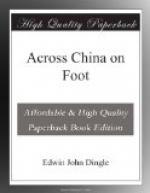Yuen-nan and Szech’wan—and a great part of Kwei-chow in the main still untouched by the increased taxation necessary to provide revenue to uphold the reforms brought about by the forward movement in various parts of the Empire—are where the aboriginal population is most evident. This part of the Empire might be called the ethnological garden of tribes and various races in various stages of uncivilization. These secluded mountain areas, their unaltered conditions still telling forth the story of the world’s youth, have been the cradle and the death-bed of nations, of vigorous and ambitious tribes bent on conquest and a career of glory.
THE MIAO
Of the Miao, with its various sections, we know a good deal. Their real home has been pretty finally decided to be in Kwei-chow province, and they probably in former times extended far into Hu-nan, the Chinese of these provinces at the present time having undoubtedly a good deal of Miao blood in their veins. They are comparatively recent arrivals in Yuen-nan, but are gradually extending farther and farther to the west, maintaining their language and their dress and customs. I personally found them as far west as thirty miles beyond Tali-fu, a little off the main road, but Major Davies found them far up on the Tibetan border. He says: “The most westerly point that I have come across them is the neighborhood of Tawnio (lat. 23 deg. 40’, long. 98 deg. 45’). Through Central and Northern Yuen-nan they do not seem to exist, but they reappear again to the north of this in Western Szech’wan, where there are a few villages in the basin of the Yalung River (lat. 28 deg. 15’, long. 101 deg. 40’).”
The Major was evidently ignorant of this Miao district of Chao-t’ong, to the north-east of the province. Stretching three days from Tong-ch’uan-fu right away on to Chao-t’ong, in a north line, Miao villages are met with fairly well the whole way; then, three days from Tong-ch’uan-fu, in a north-westerly direction, we come to the Miao village of Loh-In-shan; and then, striking south-west, through country absolutely unsurveyed part of the way, Sa-pu-shan is met. This last place is the headquarters of the China Inland Mission, where, at the present rate of progress, one might modestly estimate that in twenty years there will be no less than a million people receiving Christian teaching. These are not all Miao, however; there are besides La-ka, Li-su, and many other tribes with which we have no concern at the present moment.
So that it may be seen that from Yuen-nan-fu, the capital, in areas on either side of the main road leading up to the bifurcation of the Yangtze below Sui-fu, in a long, narrow neck running between the River of Golden Sand and the Kwei-chow border, Miao are met with constantly. And then, of course, over the river, in Szech’wan, they are met with again, and in Kwei-chow, farther west, we have their real home.




